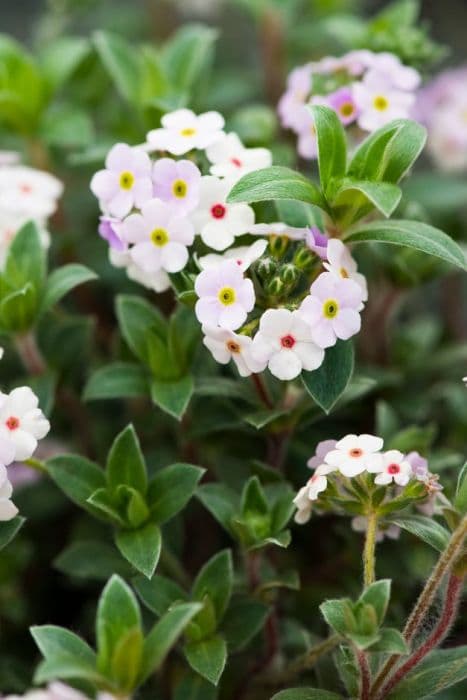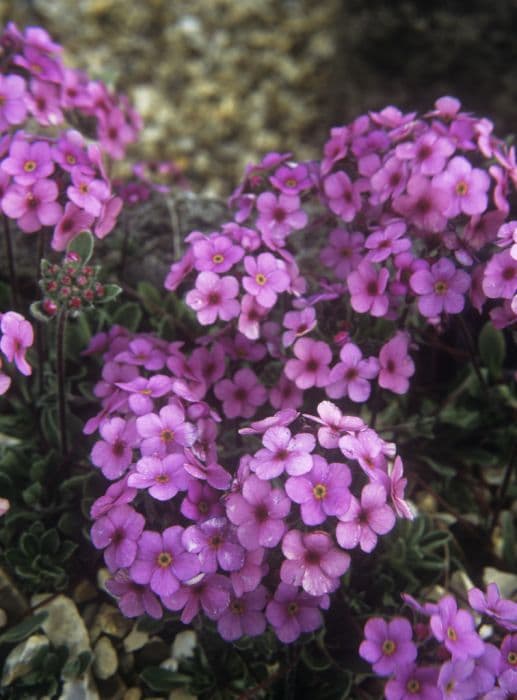Auricula Primula auricula 'Ellen Thompson' (Au/a)

ABOUT
Primula auricula 'Ellen Thompson', commonly known as Bear's ear, is a striking ornamental plant cherished for its unique and vividly colored flowers. The blossoms of this variety exhibit a dazzling palette, with petals that often come in bright shades of yellow, orange, or red. Some flowers may also have a distinct, contrasting color at their center, giving them a captivating, eye-catching look. Each petal is typically rounded with a smooth edge, and they are arranged in a circular pattern around a prominent, tube-like center that adds to their ornamental appeal. The leaves of Bear's ear are another highlight, with a fleshy texture and a somewhat waxy surface that can sometimes have a powdery dusting. These leaves are often a deep green color and can have a distinctly rounded or oval shape. They form a rosette at the base of the plant and provide a lush backdrop for the exquisite blossoms. The overall aesthetic of Primula auricula 'Ellen Thompson' is one of delicate beauty, with its harmonious blend of colorful flowers and lush foliage. Its appearance has made it a favorite among gardeners and plant enthusiasts who appreciate its ornate features.
About this plant
 Names
NamesFamily
Primulaceae
Synonyms
Bear's Ear, Mountain Cowslip, Auricula
Common names
Primula auricula 'Ellen Thompson'
 Toxicity
ToxicityTo humans
The Bear's Ear is considered non-toxic to humans. It isn't known to cause any serious side effects if ingested. However, like many other plants, it could potentially cause mild discomfort in some individuals, such as nausea or an allergic reaction if they are sensitive to the plant.
To pets
The Bear's Ear is generally considered non-toxic to pets. Ingestion might lead to mild gastrointestinal discomfort, such as vomiting or diarrhea, especially if consumed in large quantities. If your pet displays any unusual symptoms after contact or ingestion, it is wise to consult a veterinarian.
 Characteristics
CharacteristicsLife cycle
Perennials
Foliage type
Evergreen
Color of leaves
Green
Flower color
Mixed
Height
0.5 feet (15 cm)
Spread
1 feet (30 cm)
Plant type
Herb
Hardiness zones
5
Native area
Europe
Benefits
 General Benefits
General Benefits- Easy to Grow: Auricula 'Ellen Thompson' is a hardy perennial known for being relatively easy to cultivate in a variety of garden settings.
- Ornamental Appeal: With its attractive foliage and bright, colorful blooms, this plant adds visual interest to gardens and containers.
- Long Blooming: Auriculas have an extended flowering period, which ensures vibrant color in the garden for a long time.
- Attracts Pollinators: The flowers can attract bees and butterflies, supporting local ecosystems and pollination.
- Compact Size: Its small size makes it suitable for rockeries, alpine gardens, and border fronts, where space may be limited.
- Low Maintenance: Once established, the Auricula 'Ellen Thompson' does not require much upkeep and is relatively pest and disease resistant.
- Great for Containers: Its size and growth habit make it an ideal choice for container gardening, adding color to balconies and patios.
 Medical Properties
Medical PropertiesThis plant is not used for medical purposes.
 Air-purifying Qualities
Air-purifying QualitiesThis plant is not specifically known for air purifying qualities.
 Other Uses
Other Uses- Auricula Theatre Display: Primula auricula 'Ellen Thompson' is often used in a traditional display called an Auricula Theatre, which is a shelved stand specially designed to showcase the beauty of these flowers in a tiered fashion.
- Photography: Gardeners and photographers may use the striking flowers of Primula auricula 'Ellen Thompson' as subjects for botanical photography due to their unique colors and patterns.
- Art and Illustration: The distinctive flowers can inspire artists and illustrators as a subject for watercolor paintings, drawings, and even fabric designs.
- Collectors' Item: Auriculas, including 'Ellen Thompson', are often prized by plant collectors for their uniqueness and variety, creating a demand among enthusiasts for rare and unusual cultivars.
- Gardening Competitions: This particular variety might be grown and entered into gardening competitions for its ornamental value and uniqueness among Primula varieties.
- Culinary Garnish: Although not widely used for culinary purposes, the petals of Primula auricula can occasionally be employed as an edible garnish to embellish desserts and salads, adding a pop of color.
- Education: Horticultural schools and classes might use 'Ellen Thompson' as an example when teaching about plant breeding, genetic hybridization, or alpine plant cultivation techniques.
- Alpine Rock Gardens: This plant can be an excellent addition to themed garden areas that are designed to mimic the conditions of alpine environments.
- Victorian Era Reenactments: Historically popular during the Victorian era, this plant can be used for historical reenactment gardens or events to mimic the period's gardening styles.
- Floral Arrangements: While not a traditional cut flower, 'Ellen Thompson' might sometimes be used by innovative floral arrangers who seek to create unique, cottage-style arrangements.
Interesting Facts
 Feng Shui
Feng ShuiThe Auricula is not used in Feng Shui practice.
 Zodiac Sign Compitability
Zodiac Sign CompitabilityThe Auricula is not used in astrology practice.
 Plant Symbolism
Plant Symbolism- Preciousness: The Primula auricula 'Ellen Thompson', also known as Bear's Ear, has unique and often vividly colored, ornate petals, suggesting the preciousness and rarity of beautiful and cherished objects or moments.
- Delicacy: This plant's dainty appearance and fine structures convey a sense of delicacy and speak to the fragile nature of life and relationships.
- Perseverance: Bear's Ear is a hardy plant that blooms early in spring, often pushing through the remnants of snow. It symbolizes perseverance and the ability to overcome challenges.
- Hope: As one of the first flowers to bloom at the end of winter, the Bear's Ear represents hope and the promise of renewal and rebirth.
 Water
WaterBear's Ear should be watered moderately, ensuring the soil is kept moist but not waterlogged. During active growth in spring and summer, water with approximately 16 ounces of water once a week. Reduce watering to every two weeks in the fall and winter when growth slows down. Be careful not to water directly onto the foliage, as this can promote fungal diseases. Always check the top inch of the soil before watering; if it feels dry to the touch, it's time to water again.
 Light
LightBear's Ear thrives best in bright, indirect sunlight. It should be placed in a spot where it can receive filtered sunlight away from direct, harsh rays. A north-facing or east-facing window typically provides the ideal lighting conditions for this plant, ensuring it gets enough light without the risk of scorching its leaves.
 Temperature
TemperatureBear's Ear prefers cooler temperatures, thriving between 50°F and 60°F, which are ideal for its growth. It can withstand temperatures down to about 40°F, but should not be subjected to temperatures below freezing. During the summer, it's important to protect the plant from excessive heat, as temperatures above 80°F may cause stress.
 Pruning
PruningBear's Ear should be pruned to remove dead or yellowing leaves and spent flowers to encourage healthy growth and appearance. The best time to prune is after flowering in late spring or early summer. Pruning can be done every other year or as needed when you notice parts of the plant that require removal.
 Cleaning
CleaningAs needed
 Soil
SoilAuricula prefers well-draining soil rich in organic matter with a slightly acidic to neutral pH of 6.0 to 7.0. The best soil mix for Auricula would be a blend of peat, loam, and perlite or coarse sand to ensure good drainage and aeration. It's beneficial to add some leaf mold or well-rotted compost to the mix for added nutrients. Regularly check the soil's moisture level to prevent it from drying out completely or becoming waterlogged.
 Repotting
RepottingAuriculas like 'Ellen Thompson' should be repotted every 1 to 2 years to refresh the soil and accommodate root growth. The best time to repot Auriculas is after flowering or in the early fall, ensuring they are not disturbed during their blooming period. Use a slightly larger pot with fresh soil mix when repotting to keep the plant healthy.
 Humidity & Misting
Humidity & MistingAuriculas, including 'Ellen Thompson', prefer moderate humidity levels, around 50-60%. They perform well in naturally humid environments and do not require any special humidity adjustments when grown outdoors in suitable climates. Indoor plants might benefit from occasional misting or placing the pot on a pebble tray with water to increase the ambient humidity.
 Suitable locations
Suitable locationsIndoor
Provide bright, indirect light and watch watering.
Outdoor
Plant in partial shade, shelter from harsh weather.
Hardiness zone
4-8 USDA
 Life cycle
Life cyclePrimula auricula 'Ellen Thompson', commonly known as Auricula or Bear's Ear, begins its life as a seed which, when sown in well-draining soil and given appropriate light and moisture, germinates into a small seedling. Graduating from a seedling, the auricula rapidly develops a rosette of fleshy, often farinose (mealy) leaves, characteristic of the species. The rosette matures and in spring, typically in its second year, sends up a flowering stalk, which is adorned with clusters of ornate, often vividly colored and occasionally fragrant flowers. After pollination, often by insects or through self-fertilization, the flowers develop into capsules containing numerous tiny seeds. Once the seeds are fully mature, the plant disperses them into the surrounding environment, where they can sprout and start a new life cycle if conditions are favorable. Seasonally, the auricula may die back partially, especially in colder climates, but it is a perennial and will re-emerge from its rootstock with the onset of favorable growing conditions.
 Propogation
PropogationPropogation time
Spring to Summer
The most popular method of propagating Primula auricula 'Ellen Thompson', commonly known as auricula, is by division. This should ideally be done in late summer or early autumn. To propagate by division, carefully lift the parent plant from the soil and gently separate the offsets, which are the small plantlets that have formed at the base of the mature plant. Each offset should have its own roots. Once separated, the offsets can be planted directly into well-draining soil in a shaded location. Watering should be moderate, to establish the plants without saturating the soil, which can lead to rot. This method allows gardeners to create new auricula plants that are identical to the parent plant and begin to establish them before the winter months.









